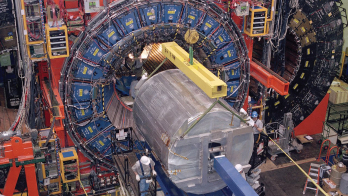by Dan Green, Cambridge Monographs on Particle Physics, Nuclear Physics and Cosmology, 361 pp, 0 521 66226 5, £65/$100.
The 12th volume of the Cambridge Monograph Series on Particle Physics, Nuclear Physics and Cosmology again concerns particle detectors. In this case the main emphasis is not on the construction of these devices but rather on the underlying physics.
Dan Green has worked in particle detection and identification in many laboratories – from Stony Brook to the ISR, and from Fermilab to the preparation of LHC experiments.
The book begins with a recollection of the size and energy scales involved in different physical processes. The order of magnitude of atomic and nuclear processes is explained by fundamental physics principles and illustrated using everyday examples. The introductory chapter provides the basic numerical data needed to characterize the interaction probabilities of different particle species.
The main body of the book is subdivided into non-destructive measurements, such as time, velocity, ionization, position and momentum measurements, where the interaction of the incident particle transfers very little energy to the detecting medium; and destructive techniques, such as electron and hadron calorimetry, where the lost energy is a significant fraction of the kinetic energy carried by the particle. Characteristic features of different detectors are partially derived using dimensional arguments. For practical operations, rules of thumb are provided.
All of the methods presented aim to identify the incident particles, a goal that can often only be achieved by combining different techniques. Such a complete set of measurements is presented in the final chapter, using the example of a general-purpose detector.
The author successfully explains the operation of each type of detector from first principles, without rigorously deriving the theoretical background. Readers interested in the theory are referred to the appendices.
The presented applications of particle detectors are illustrated with many numerical examples, which clearly show that Green has “hands-on” experience in constructing and optimizing these devices. Some of the home experiments, however, like deflecting the electron beam of a TV set with a permanent magnet, should be treated with caution. This is fine on a black-and-white screen but can produce irreversible damage on a colour TV.
Various interaction processes are visualized using bubble and cloud chamber events, although these old-fashioned detectors are not described in detail. There is no mention of nuclear emulsions, and very little on neutrino interactions, even though the search for neutrino oscillations and the first direct observation of the tau neutrino have demonstrated that exotic and rare processes can breathe new life into old technologies. There is certainly some demand for the basics of neutrino interactions from the growing number of experiments in astroparticle physics.
Many of the instructive diagrams are taken, with good reason, from the relevant chapters of the excellent Review of Particle Physics by the Particle Data Group.
This book presents an attractive and comprehensive introduction to the physics of particle detection. The reader is guided by practical examples from everyday experience. It will be of interest to physics students and will also be a valuable reference for the experienced detector builder. The design of actual particle detectors may be subject to change over the coming years, but the underlying physics principles will stay the same. The book will thus remain useful for some time. The publishers should also be encouraged to issue an affordable paperback edition.








